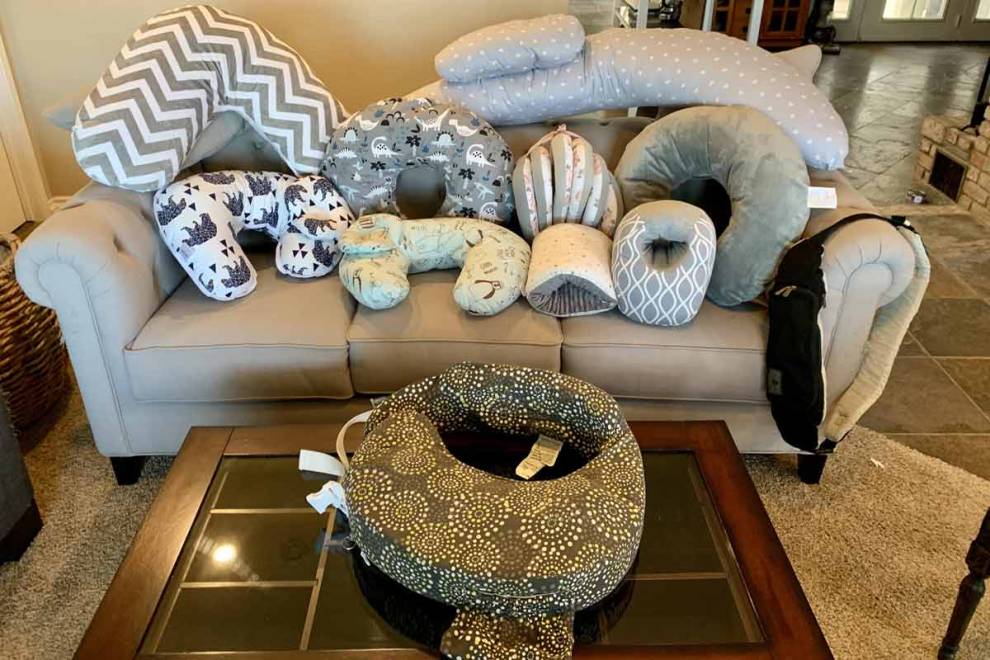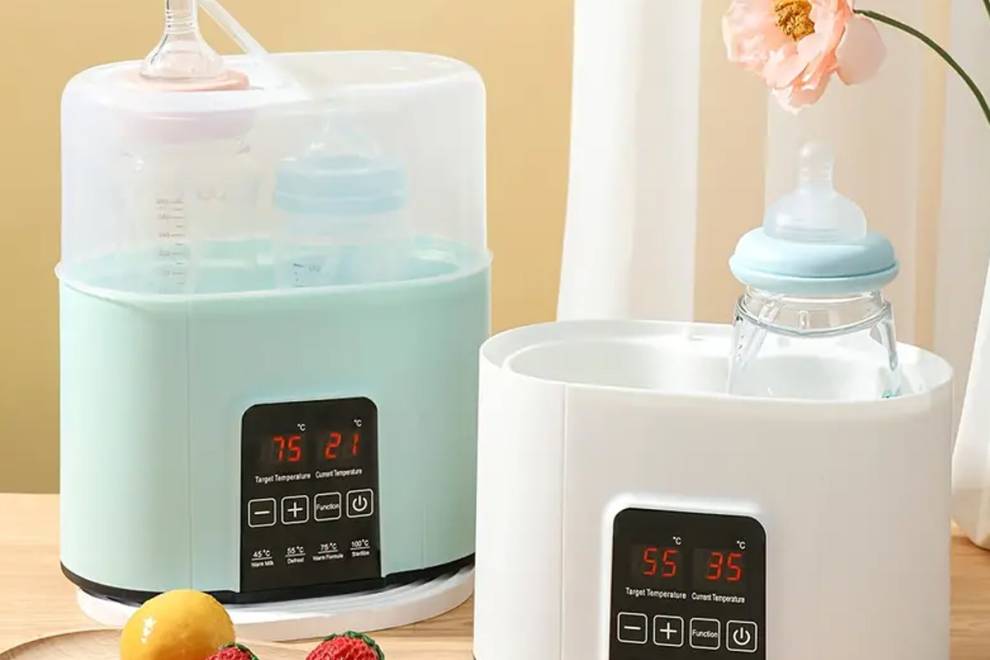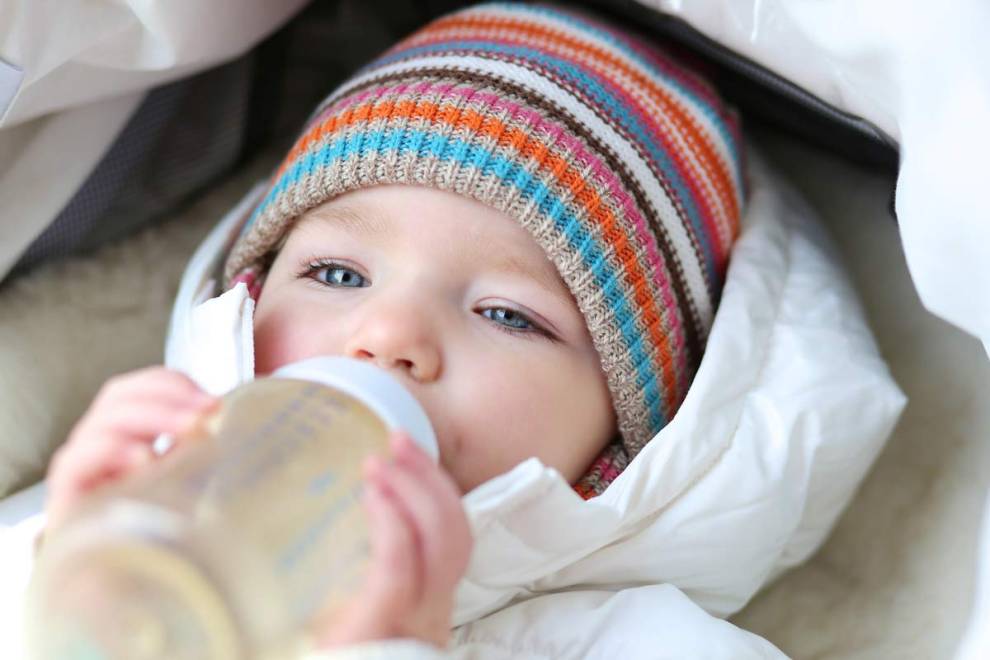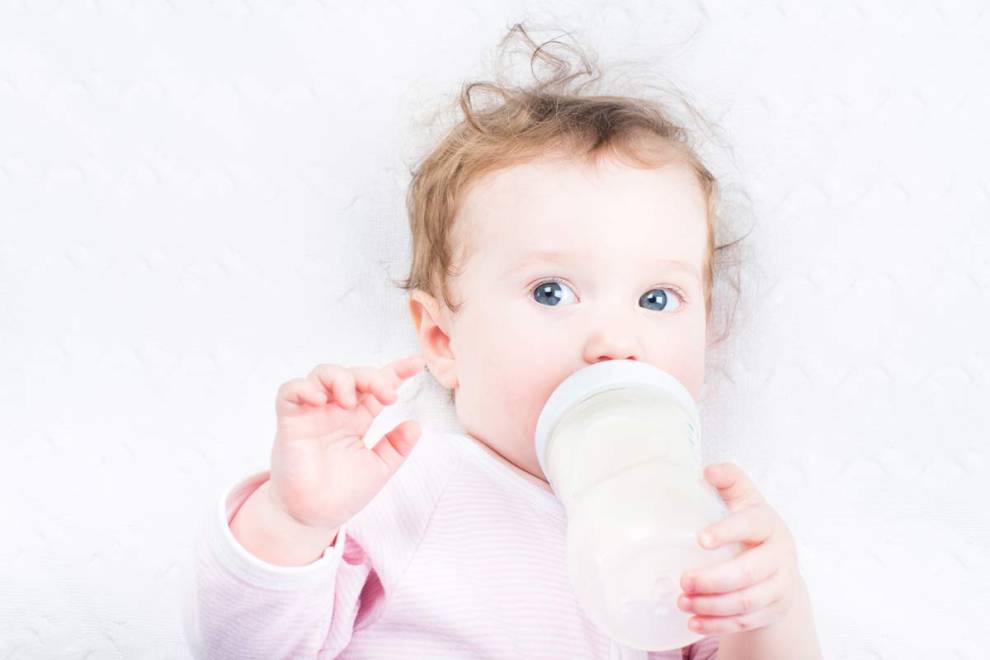Protect your little one and your precious remaining sanity with these top childproofing tips.
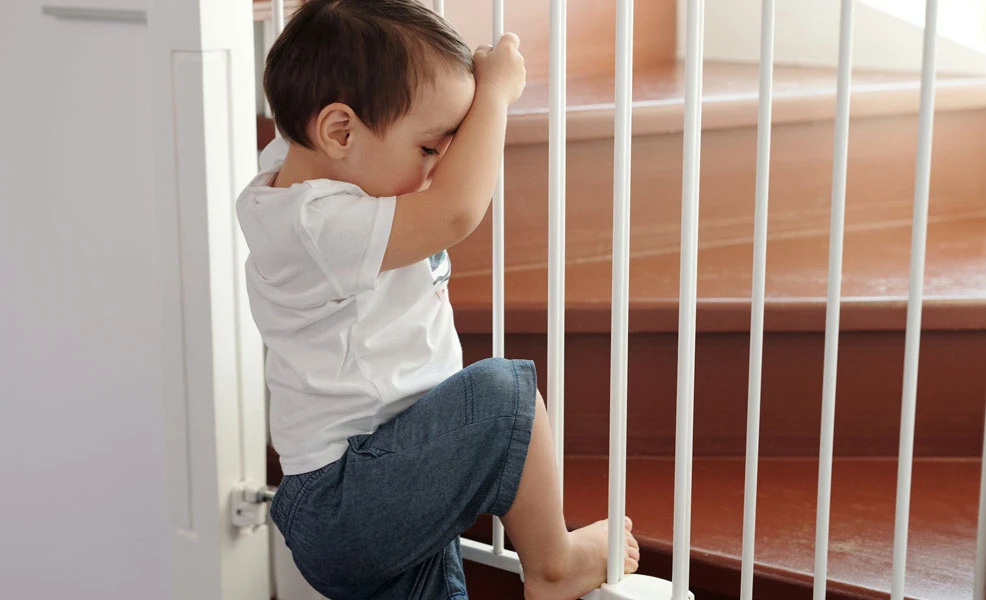
Mommyhood101 independently tests and curates baby gear to help you make informed decisions. If you buy products through links on our site, we may earn a commission.
Once your baby starts scooting, rolling, crawling, pulling themselves up, and walking around, you'll soon realize why babyproofing is an essential step in preparing a safe and stress-free household!
We solicited advice from our 22,000+ Facebook and Twitter followers and pulled together this comprehensive list of childproofing ideas for your home. Check out our table of contents to select an area of the home, and get started!
Childproofing Kitchens
The kitchen is probably the most important place to begin your childproofing journey. The most important risks arise from the cabinets, drawers, oven doors, dishwasher doors, oven and stove knobs and buttons, refrigerator doors and water/ice dispensers, and anything on the counter that's within arm's reach.
- For babyproofing cabinets and drawers, we recommend the Eco-Baby Magnetic Locks, which are easy to install, reliable, durable, and do not pinch fingers like the old latch-style locks.
- For babyproofing the oven door and dishwasher door, we recommend the Munchkin ExtraGuard Latches that work really well for any appliances that are within your baby's reach. Same goes for the garbage can if it's not kept in a cabinet.
- For babyproofing oven and stove knobs, we recommend the Safety 1st knob covers that work really well to keep curious babies and toddlers from turning the knobs. None of these options requires drilling holes into your cabinets, and we've never seen them ruin the finish of a cabinet or appliance.
- Most refrigerator or freezer doors are difficult to open and your baby likely won't be strong enough to figure out how to open it. But you never know, and if you want to be sure this isn't an issue, you can use the Munchkin ExtraGuard Latches to keep the door closed. The second thing to worry about on a refrigerator is the water and ice dispenser, which can quickly become a toy for a curious toddler. Nothing you can really do about this other than disabling it - most have a child lock feature that you can enable.
- The garbage disposal, if your kitchen is equipped with one, may very well be the most dangerous switch in your entire house. Consider installing a switch cover to prevent the switch from being accidentally flipped, or unplugging the disposal entirely (under the sink).
Remember that while something might not be within reach for a crawling or pulling-to-stand baby, it might become within reach when they are in an exersaucer, walker, high chair, or anything else that increases the height of their reach. This becomes especially important when making sure there is nothing dangerous (hot, sharp, heavy) within reach on the counter. Also realize that any cords that dangle off the counter are both tempting and dangerous, so be sure to keep the cords tucked behind the small countertop appliances and push them to the back of the counter.
We also want to point out that we've had great success in providing your baby and toddler with a kitchen cabinet of their own, or an entire play kitchen of their own to experiment with. We review play kitchens here, but the cheaper option is to empty a lower kitchen cabinet and throw in some empty tupperware containers and big spoons for your baby to play with. It will become a great play space for your baby while you're cooking or cleaning up in the kitchen!
Childproofing Bathrooms
The bathroom has very similar risks to the kitchen, but also include the toilet and bathtub (or shower). The bathroom is typically easier than the kitchen because you can simply close the door to prevent your baby from entering. Realistically, either you will forget to close the door or your baby will figure out how to turn the knob (we have advice for that below). So even if you think you'll just keep the bathroom door closed, we suggest fully babyproofing your bathroom. The good news is that there's really nothing special here in terms of products.
- Secure the bathroom cabinets and drawers, just like in your kitchen (above).
- Secure the toilet lid (and garbage can lid) down with a quality latch like the Munchkin ExtraGuard Latches, which we've had great success with.
- Place soft rubber covers on faucets that are within the baby's reach.
- Consider contacting a plumber to install a scald-guard on your sink and tub, to prevent hot water burns.
In terms of babyproofing your shower or bathtub, we have a couple pieces of advice. The most obvious (we hope) piece of advice is to never leave a baby unattended in or near a bathtub, whether it contains water or not. There are not only risks of drowning, but also risks of scalding and burns from curious hands testing out the hot water knob. Consider investing in a hanging shower organizer to keep everything (shampoo, conditioner, soap, etc) high up and out of reach, and a soft bathtub mat to make for a soft landing if your baby does decide to go head-first into the empty tub! .
- Most shower doors can be secured with the Munchkin ExtraGuard Latches.
- Regarding the tub, make sure that any shampoo and conditioner or any other non-toy products are high up and out of reach, and consider a soft bath mat just in case.
Childproofing Stairs
Babies and stairs are a very dangerous combination. Even the least curious babies will eventually find their way to staircases, and many will not hesitate to investigate them in a way that's way too close for comfort. Both staircases going up (heading upstairs) and down (heading downstairs) need to be equipped with baby gate designed for the mounting situation. Fortunately, baby gates have come a long way, and are now more versatile for various wall and bannister configurations, customized swing direction, pinch-free locking mechanisms, one-handed operation, and options for pressure-mounted or hardware-mounted installations. Check out our full baby gate buying guide for more details on how to find a safe baby gate option for the top and bottom of stairs.
- Baby gates placed at the top or bottom of the stairs should generally be hardware-mounted. This will help you avoid using a gate that has a bottom bar anywhere near the stairs, to avoid the serious tripping hazard.
- Consider the added safety of a baby gate that automatically swings shut. So many parents forget to close a safety gate and this defeats the purpose of having one in the first place.
Childproofing Doors
Doors present a danger for a few reasons. First, they are a pinching hazard for little fingers and hands. Second, they provide access to dangerous areas like outdoors, stairways, bathrooms, and closets. Some doors you'll want to keep open, and some you'll want to keep shut.
- For doors that you want to keep open, consider investing in the Wittle Finger Pinch Guards that prevent your child from closing a door all the way. It attaches easily (without adhesive or anything) to the edge of the door and keeps it from shutting completely. Pro-tip: you can also put these guards on the top of the door close to the hinge, and that will keep the door pretty wide open at all times.
- For doors that you don't want your baby to open, solutions for keeping them shut will depend on the type of knob you have. If you use a traditional round knob, you can use knob covers just like on an oven or stove. A good example is the Wittle Door Knob Safety Cover, which attach over your knob and require you to squeeze the cover in a certain way to get enough grip on the knob to turn it. If your doors use a lever-style knob, there are new lock devices for that, but they do require you to attach the lock to your door with adhesive and generally they don't work very well (and there is no way to release them from the other side of the door if you get into that situation). For that reason, we suggest another option: if you're tall enough to reach the top of your door, then consider using a GlideLock that attaches to the top of the door. We've been using these for a few years and they are amazing for doors with lever door handles.
Childproofing Furniture and TVs
Most chairs, couches, and tables do not require any special babyproofing. There are three primary babyproofing challenges here. The first is any furniture that can be climbed on and might tip over, including dressers, bookshelves, hutches, televisions, and armoires. This applies to babyproofing bedroom furniture, living room furniture, and any other furniture around the home. Second is any furniture with sharp edges that could be dangerous for a bumped head or other body part; examples include glass tables, tables with a granite or other stone top, and wooden tables with sharp edges and corners. Third is furniture with drawers that you don't want your baby getting into, in addition to the fact that climbing on or into drawers introduces major tipping hazards for the furniture.
- For anything that could tip over if you grabbed the top and pulled forward as hard as you could, secure it by using tether straps. There are some great new options that basically use one attachment for the furniture or TV and the other the wall, and then a zip tie to attach the two together. We've had luck with these Anti-Tip Anchors.
- To babyproof sharp corners and edges, you can attach soft padding with adhesive. Be sure not to skimp on this one, because when it comes time to take them off your furniture you'll be annoyed by all the residue that a cheap adhesive will leave behind on your furniture or countertops. Roving Cove sells a great option for this, that comes in several different colors to match your furniture.
- To babyproof drawers of furniture, use the same strategy that we suggest for kitchens and bathrooms. Rather than using those old clips that lead to finger pinches and can usually be figured out by the age of about 12 months, check out the latches made by Munchkin.
Childproofing Windows & Coverings
This is a really important step in babyproofing and one that many parents don't even consider. And let's not get into the number of babies and toddlers that get injured or die due to strangulation from curtain cords. Not worth even taking a risk here, here is our advice:
- Free option: Trim the curtain cord to a very short length that is completely out of the reach of a toddler (even if they're standing on a chair). Start with setting the curtain or blinds to its lowest (most extended) position. Then take the plastic or wooden cap off the end of the cord. Plastic ones usually just swing open, wooden ones are usually tied on. Trim the cord to a very short length, up close to the top where it attaches to your window. Then reattach the cap to the end. Never open the blinds, since that will extend the cord down to a reachable level.
- Better option: Spend the 10 bucks and invest in a cord-winder that attaches to your curtain cord and keeps it wound up on a little spool. For most blinds and curtains, something like the Iba Innovations Cord Winder will work well. If you're dealing with an especially long or thick cord, then consider buying a few screw-on or adhesive cleats.
- For windows and sliding doors, keep them locked when not in use. Many replacement windows have a little tab that you can flip open to prevent the window from opening wider than a few inches. You can use a wooden dowel for this purpose on a sliding glass door. If your windows or doors do not have that feature and you would like to keep them open, check out some of the easy to use baby locks for windows and sliding glass doors.
Childproofing Electronics
Your entire house is full of switches, outlets, phone jacks, cable jacks, network jacks, and electric cords. Most houses have cords resting on the floor and going up the side of furniture, outlets every 6 to 8 feet across entire rooms and hallways, and empty jacks that are tempting places to stick fingers and objects. Here is what we suggest:
- Secure any dangling cords. Examples are cords dangling on bedside tables from lights, alarm clocks, or phone chargers. Cords going to lamps, humidifiers, vacuums, laptop or phone chargers, and anything else pose a hazard. Figure out how to route them behind furniture and tie up (try using zip-ties) any slack that's within reach.
- Cover your outlets. There are tons of options for this. You can replace all of the outlets with tamper-proof outlets, but that's a bit expensive and requires hiring an electrician. A cheaper option is to invest in the classic plastic outlet covers or the bigger swing-open outlet covers that stop not only access to the outlet itself but also prevent cords from being yanked out of the wall.
- A phone jack uses low voltage wiring but can still deliver quite a shock to a curious baby or toddler who sticks their finger in the jack. If you don't use the phone jack, consider removing the cover and detaching the wires from inside, and then screwing the cover back on. At least you can be confident that there's no power flowing to the jack.
- Any dangerous switches, like the ones that control a garbage disposal or central vacuum system, should be guarded by a safety cover.
- Remove any tall or wobbly standing lamps, or tether them to the wall.
Childproofing Air Vents
If your home doesn't use radiators, it's likely that it is ducted with heating and air conditioning ducts that terminate in air vents, floor registers, and air returns. These are frustrating to parents for a few reasons. First and most obvious, babies and toddlers find way too much enjoyment in sticking their fingers and little toys down into air vents and floor registers. Second, most air vents, especially floor registers, are not securely attached to the floor. Sometimes they're easy to simply pull up and off the floor. Here's our advice for babyproofing air vents:
- To prevent things from being lost in air vents and floor registers, consider adding a mesh lining or pouch underneath the vent. Amazon sells an easy to use Floor Register Trap that basically is a net you put under the register to catch anything that falls (ahem... is pushed) inside. Even if one of those won't fit, it gives you an idea of how to do it with some cheap netting material and gaffers tape.
- To prevent floor registers from being lifted up, this a bit more challenging. If the floor register is on a hardwood floor, you can pull it up and place some good quality double-side adhesive tape to help hold it down. If the vent is on carpet it's a bit more problematic. We've seen people solve this with complicated spring-loaded mechanisms that hold the vent down in place, but realistically we suggest hiring a carpenter or HVAC professional to secure the vent down if this is really an issue in your home.
Childproofing Railings
The vertical part of your railing or banister is called a baluster. The balusters hold up the railing and often add a stylish look with spindles or other decorations. In older homes or with any railings that were not built to proper local building codes, there can be large gaps between the balusters that can be a risk for small and curious babies and toddlers. Here is what we suggest:
- If the spacing between the balusters does not meet building code (the gap should be less than 4" wide), then you should contact a carpenter or contractor to consider getting them replaced. This is true for the stairs inside your home, and the railings and stairs on decks, patios, and balconies. Yes, this might get expensive, but the alternative is really scary.
- Even with a spacing less than 4", you might still be worried about the railing situation. Another option is to install a mesh netting that is made exactly for this purpose, such as the one by Roving Cove for outdoor use, or the one by 4UHeart for indoor use.
Childproofing a Fireplace
A fireplace is a great, relaxing, and sometimes romantic way to provide warmth and atmosphere to your home, but both wood and gas fireplaces (and wood stoves) get very hot during operation and pose many risks for babies and toddlers. These risks include radiant heat emanating from the surfaces, blown heat coming out of any fan unit on it, the temperature of the fireplace frame or glass itself, smoke or carbon monoxide coming into the home, the risk of embers popping and flying out of the fireplace, and more.
- For a wood fireplace, be sure you have a fireplace screen installed. Preferably this would be mounted to the wall rather than free-standing. We also suggesting having an additional layer of separation provided by a fireplace baby gate that is designed for exactly this purpose and increases the distance between your baby and the dangers of a fireplace.
- For a gas fireplace, be sure the appropriate glass and/or screen guard is properly installed on the front. Same with a wood fireplace, get an additional layer of separation with a baby gate designed for this purpose.
- As always, but especially when using a fireplace (wood or gas), be sure your home is equipped with good smoke detectors and carbon monoxide detectors, and make sure the batteries are replaced every year and it is functioning properly.
Childproofing a Pool or Hot Tub
Pools and hot tubs are extremely dangerous for babies, toddlers, and even bigger kids. Every year there are horror stories of children crawling, walking, climbing, jumping, or falling into pools and hot tubs and never making it out. If that doesn't scare you enough, over 500 kids a year drown in a pool in the USA. There are more complete resources for childproofing your pool, but we will cover the basics here:
- To childproof a hot tub, invest in a secure locking cover that is correctly sized, and test it frequently to make sure it's functioning as intended. If possible, install a fence around the hot tub, an alarm that will sound if the cover is removed or water is disturbed, and keep exterior doors locked to prevent your child from wandering out of the home towards the "fun places" outside. If you cannot do these things, get rid of your hot tub.
- To childproof a pool, you must install a fence at least 5-feet tall around the entire pool with a locking and self-closing access door. Invest in a pool alarm that will sound if the water is disturbed, or a wrist-worn pool alarm (like the Safety Turtle 2.0). Lock the exterior doors of your home when you're inside to prevent a wandering and curious child from finding the pool. If you cannot afford a fence around your pool, then get rid of your pool entirely. There is no sense risking your child's life by saving some cash or otherwise neglecting to secure the risk.
Additional Childproofing Tips
- If you are not confident discovering and managing the risks in your home, you can find and hire a professional childproofer to come into your home and install age- and home-appropriate systems that will give you peace of mind. Ask on local community boards on Facebook or other platforms you use, many parents will have hired an expert to do the work for them, and in our experience, for a typical home it usually only costs about $1000 for them to secure the most important things (including parts and labor).
- In case it isn't obvious, never leave a hot iron or any other hot appliance (space heater, curling iron, blow dryer, etc) anywhere near your child, and make sure the cord is secured and well out of the reach of your child.
- Invest in zip-ties and twisty-ties for childproofing hotel rooms and anywhere else you travel. They are great for securing cabinets, drawers, cords, and anything else that might prove dangerous in a hotel room or during travel.
- Tablecloths are an easy way for a child to pull everything off a table, whether it's the dining room or coffee table. Definitely get rid of them and consider using placemats instead.
- Childproofing a laundry room follows the same principles as child-proofing the kitchen and any other appliances. The doors should be secured closed, and all cleaning products should be well out of your child's reach.
- In the nursery, avoid placing anything in or around the crib, including a mobile, crib bumper, pillows, blankets, stuffed animals, or anything other than the mattress, mattress cover, and sheet.







